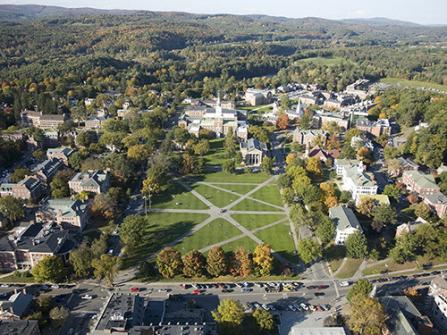Welcome to Dartmouth Hitchcock Medical Center
We have everything that you would expect a major academic center to have, from inpatient wards, outpatient clinics, to a cardiac Cath lab. Dartmouth Hitchcock Medical Center is a beautiful institution and provides a welcoming collegial atmosphere.
Program information
Mission statement
Our fellowship graduates meet the highest standards of patient care, contribute meaningfully to the medical literature, and mentor junior colleagues throughout a successful career in dermatopathology.
Program aims
Mentoring graduates of pathology and dermatology residency programs through rigorous training that exposes them to a broad array of dermatopathology specimens and collaborative research, so that upon graduation our fellows have become our junior colleagues, prepared and confident to begin their careers as dermatopathologists in academic and community practice settings.
Program details
We prepare colleagues from both dermatology and pathology backgrounds to provide excellent diagnostic services for their patients. Fellows encounter a broad spectrum of inflammatory and neoplastic skin diseases from our dermatology clinics, surgical centers, and our multidisciplinary cutaneous lymphoma and melanoma oncology groups. We maintain an academic environment characterized by intellectual curiosity and by respect among faculty, residents, support staff, and patients.
Faculty
Rotation schedule
Curriculum: Dermatopathology rotations - 1 Block = 4 Weeks
All Dermatopathology fellows, regardless of prior training, complete the following rotation:
Dermatopathology sign-out – 12 blocks
The fellow spends, on average, one half of each weekday, during the first eight months, evaluating dermatopathology specimens and reviewing these specimens with a faculty dermatopathologist from 9:00 am - 12:00 pm. Ample time is allotted for the fellow to preview cases in the afternoon and morning. During the last four months, the fellow devotes their entire time to dermatopathology, honing their ability to draft concise, clinically actionable final reports.
Scholarly activity
The fellow works with all dermatopathology faculty members in developing an original research project with the goal of publishing the results as a manuscript in a peer-reviewed journal. The fellow is responsible for collecting and interpreting data, presenting an abstract as a platform at a national meeting, drafting the manuscript, and making the appropriate revisions to ensure that it is acceptable for publication. Fellows, regardless of their career plans, have the option to present their research to the department(s) in an expanded lecture format. The fellow, while drafting the final manuscript, will temporarily be excused from all activities besides tumor boards, teaching, and grand rounds at the discretion of the program director.
The curriculum path for the dermatopathology fellow is based on whether the fellow has completed residency in Pathology or Dermatology.
Pathologists
Clinical Dermatology – 8 blocks
The pathology-trained fellow shadows our experienced dermatologists with the aim of seeing a wide variety of dermatologic disease manifestations. The fellow gains insight into the clinical diagnosis and treatment of specific dermatologic illnesses by shadowing specialists in general adult dermatology, pediatric dermatology, Mohs micrographic surgery, melanoma and pigmented lesions, high risk non-melanoma skin cancers, cutaneous lymphoma, contact dermatitis and occupational dermatology, rheumatologic dermatology, and inpatient consultations.
Dermatologists
Surgical Pathology – 6 blocks
The dermatology-trained fellow shadows highly subspecialized pathologists with the aim of seeing a variety of disease manifestations across all organ systems. There is often one-on-one time spent at the microscope with expert diagnosticians in the fields of breast, cardiothoracic, ENT, gastrointestinal, genitourinary, gynecologic, pediatric, hematologic, and bone and soft tissue pathology. The fellow will observe gross dissection of a variety of anatomic pathology specimens; however, their aim is to see as much and as diverse an array of cases under the microscope as possible. Study sets, reference materials, and quizzes are also available to gauge knowledge and progress.
Hematopathology and Flow Cytometry – 0.25 blocks
The dermatology-trained fellow assists in the interpretation of bone marrow biopsies and aspirations, blood smears, and Wright's stained body fluids. Fellows also gain exposure to flow cytometry, which is integrated into the diagnosis and interpretation of the daily hematopathology sign-out. Study sets, reference materials, and quizzes are also available to gauge knowledge and progress.
Cytopathology – 0.25 blocks
The dermatology-trained fellow gains experience in preparation and interpretation of gynecological and non-gynecological cytopathology specimens in order to appreciate the importance of cytomorphology in the general practice of pathology. The fellow is required to review 200 cases.
Histology and Immunohistochemistry Laboratory – 0.25 blocks
The dermatology-trained fellow familiarizes with the operation of a large histology and immunohistochemistry laboratory, which includes developing an appreciation for laboratory workflow, tissue processing machines (e.g. automated staining procedures), quality assurance, quality control, and quality improvement.
Microbiology – 0.25 blocks
The dermatology-trained fellow receives a general introduction to bacteriology, mycology, parasitology, virology, serology, and automation in a clinical microbiology setting. Topics include the interpretation of growth on various media, smear interpretation, automation, antibiotic sensitivity testing, quality assurance, and serologic testing. A set of case-based study questions are provided to guide reading. Daily laboratory rounds with the Medical Director and Supervisor include the discussion of interesting findings and their clinical correlations.
Molecular Pathology – 0.5 blocks
The dermatology-trained fellow gains exposure in our Clinical Genomics and Advanced Technologies (CGAT) laboratory to the basic techniques associated with nucleic acid-based diagnostic testing, including but not limited to: DNA isolation, restriction enzyme analysis, electrophoresis, Southern blotting, polymerase chain reaction, DNA sequencing, and hybrid capture. Fellows learn how molecular testing is used to diagnose oncologic, infectious, and genetic diseases.
Autopsy – 0.25 blocks
The dermatology-trained fellow develops exposure to gross and microscopic post-mortem pathology by observing in the techniques of autopsy dissection, preparation of sections, evaluation of microscopic slides, and interpretation and clinico-pathologic correlations.
Working at Dartmouth Hitchcock Medical Center
We offer programs and benefits, including stipends, insurance, and assistance programs.
See also important/required GME policies to read prior to your interview:
Conferences
The Dermatopathology Fellow participates in regularly scheduled lectures, tutorials, seminars, and conferences.
| Conference | Frequency |
|---|---|
| Cutaneous Lymphoma Tumor Board | Monthly |
| Dermatology Grand Rounds | Bi-Monthly |
| Melanoma Tumor Board | Bi-Monthly |
| Pathology & Laboratory Medicine Grand Rounds | Monthly |
| Anatomic Pathology Didactic Conference | Weekly |
| Clinical Pathology Seminar | Weekly |
| Laboratory Management | Seminar |
Leadership Preventive Medicine Residency (LPMR)
- Builds on TDI strengths in outcomes research, improvement, population health, and institutional commitment to quality, safety, and value
- MPH degree from TDI – tuition paid by the program!
- Opportunity to lead change and improvement at Dartmouth Hitchcock Medical Center
- Two-month governmental public health experience
- Dedicated faculty coach; teaching opportunities; unique multi-specialty resident/fellow/faculty group
- May incorporate research in one year of the program (3 + 1)
- Continue clinical work
- Moonlighting allowed
- Graduates are in demand and employers are very interested in their mix of clinical skills plus improvement and change knowledge and experience
- Visit the LPMR web page, email tina.c.foster@hitchcock.org or contact an alum to learn more!
Contact us
Phone: 603-650-9485
melissa.s.zebrowski@hitchcock.org (Program Coordinator)
Life in the Upper Valley
The Upper Connecticut River Valley area of central New Hampshire and Vermont includes the towns of Hanover and Lebanon, New Hampshire. Known as "The Upper Valley," this region attracts people from around the world for its scenic beauty.
The Upper Valley area offers a wide variety of cultural and recreational activities for people of all ages.

